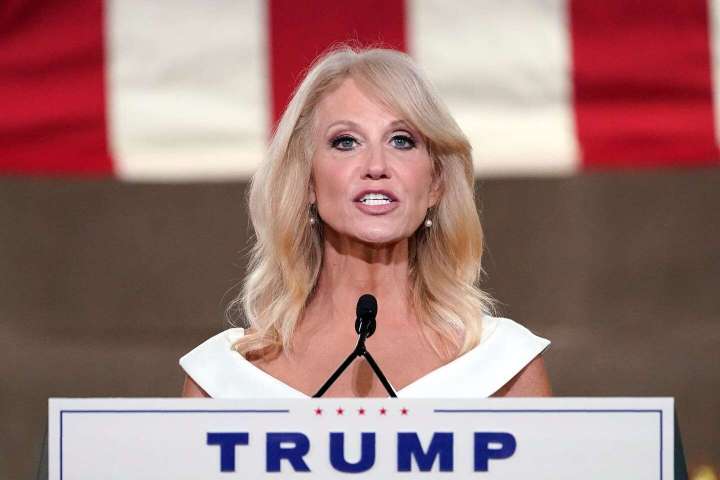Kellyanne Conway began a new job this week, appearing on Fox News as a paid contributor. It’s a good fit for Conway, who has always excelled at presenting punchy rhetorical points on the fly. It’s also a good fit, of course, because Conway has spent most of the past six years deploying such points in service of Donald Trump and his politics — precisely the sort of thing Fox News viewers have grown accustomed to hearing.
The politics-religion overlap is murkier than Kellyanne Conway suggests

On Tuesday night, Conway appeared on Sean Hannity’s eponymous show. When Hannity asked whether Conway expected to see “a dramatic demographic shift this election,” she replied that she did — particularly among Hispanics.
“Hispanics are realigning,” she said, first pointing to economic considerations as a cause. Then, she added, “they’re also very religious and they see a Democratic Party that’s openly hostile to religion most days. They can’t even give you thoughts and prayers when there’s a tragedy. It’s only thoughts now.”
This is not an uncommon argument. But it’s an overly simple and, in part, an explicitly dishonest one.
As a general rule, it is true that Hispanic and Black Americans are more likely to identify as Christian and less likely to say they have no religious identity than White Americans. Data from the biannual General Social Survey (GSS) shows that over the past two decades, religious identity as Christian has waned across racial groups and rejection of religious identity has increased. You can see this in the two graphs in the left-hand column, below.
Conway’s point, though, is centered on the right-hand column. Democrats are more likely to reject religion than Republicans — if we’re talking about White Democrats. Non-White Democrats identify along religious lines about the same way that White Republicans do. There were not enough Black and Hispanic Republicans included in the survey to show on the graph, which says something by itself.
This is only one measure of religion, of course. The GSS also asks about religious attendance where, again, we see that Whites are least likely to say they attend religious services regularly.
But that’s mostly because White Democrats are much less likely to do so. White Republicans attend religious services at about the same rate as Black Democrats.
So should we assume that Black Americans will similarly “realign” with Republicans? Well, no, because we understand that the religious traditions between those groups are largely dissimilar and because we recognize that there are other historic reasons that Black Americans align with the Democratic Party. Church attendance, in fact, likely reinforces that alignment.
What these graphs are reinforcing, really, is that the distinction between religious identities can be as important as the distinction between religious and nonreligious. At the outset, we considered religious identity through the lens of Christianity, because when Conway talks about religion she’s talking about the particular version of religion that is most common in her party. When she talks about the left’s purported “hostility” to religion, she’s talking about conflicts rooted in how her allies think religion should be practiced and manifested.
There are wide differences in how different religious groups overlap with political preferences. Pew Research Center matched voter files with polling to determine how religious identification related to voting in the 2018 midterm elections. It was a broadly Democratic-friendly election, but if we compare the margin among religious groups to the national margin, we get a sense of the spread.
The margin among White evangelical Protestants was 73 points more Republican than the national margin. Among White Catholics, it was 29 points more Republican. Among Hispanic Catholics, though, it was 35 points more Democratic. Among Black Protestants, it was 80 points more Democratic.
There was a shift to the right among both Blacks and Hispanics in 2020, as Pew’s data documents. But the gaps above are wide. If White Catholics and Hispanic Catholics deviate by 64 points in their national vote margin, that suggests pretty strongly that there are other pulls on political choice besides simply religious identity. A third of Trump’s support in 2020 came from evangelicals, according to Pew, a group with a very specific view of religion and religion’s role in society that is not shared even by other Christians.
Conway’s certainly right, though, that some Hispanics are increasingly choosing to vote Republican. Texas Monthly’s Jack Herrera wrote an excellent assessment of the shift in the southern part of that state in 2020. To oversimplify, the suggestion from Herrera’s article is that religious identity is a subset of cultural changes that are affecting vote choice. This doesn’t conflict with Conway’s assessment, necessarily; it’s just a different focus.
The focus deployed by Conway is unsubtle. That Democrats are “openly hostile” to religion will likely come as a surprise to the heavy majority of Democrats who are religious, including White Democrats. It will come as a surprise to President Biden, a practicing Catholic who makes a point of attending service each week — and who defeated Conway’s boss in 2020, a president whose trips to churches were inseparable from politics. Her example is that Democrats object to the phrase “thoughts and prayers,” which, of course, is not an objection to praying but to Republican reliance on the phrase as a response to mass shooting events.
This is one reason Conway is so good at what she does. She knows the data, certainly; her background is in polling. She’s adept at using factual points as a jumping off point for rhetorical ones. Like that Hispanics are more religious than (White) Democrats — ergo, they will be turned off by the purported anti-religious tendencies of the left.
No wonder Fox News wanted to bring her onboard.






